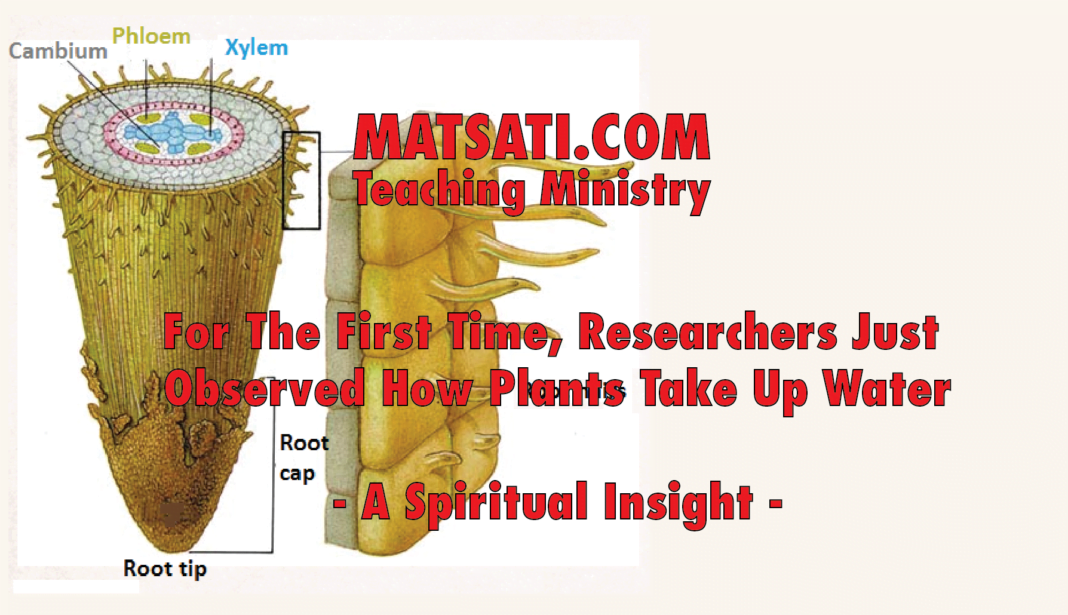Scientists have recently reported [1] on the ability to image water fluxes in cells at high temporal and spatial resolution for the first time in human history. The researchers used Raman microspectroscopy coupled with hydrodynamic modelling to achieve this goal of visualizing the hydrodynamic mechanism of water within living root tissue cells. How plants absorb water has remained a bit of a mystery until now. The researchers were able to develop this imaging technique which allowed them to watch the process of water uptake but not just uptake, also how the water moves around as well. Water functions in plants similar to our blood, moving around essential nutrients, minerals, and biomolecules throughout the living structures. The key to this technology is to observe the living plant take up water without damaging the plant. In order to do this a sensitive temporal laser-based optical microscopy technique was used to observe the movement of water non-invasively and non-destructively in the living cells.
References
- Pascut, F.C., Couvreur, V., Dietrich, D. et al. Non-invasive hydrodynamic imaging in plant roots at cellular resolution. Nat Commun 12, 4682 (2021). https://doi.org/10.1038/s41467-021-24913-z
Raman spectroscopy is named after an Indian physicist C. V. Raman. The Raman spectroscopic technique is typically used to determine vibrational modes of molecules and crystalline solids. Raman spectroscopy is commonly used in chemistry to provide a structural fingerprint by which molecules or metal oxides can be identified. Raman spectroscopy relies upon inelastic scattering of photons, known as Raman scattering. A source of monochromatic light, usually from a laser in the visible, near infrared, or near ultraviolet range is used. The laser light interacts with molecular vibrations, inducing polarization in the atoms which creates a dipole and creating excitations in the system, resulting in the energy of the laser photons being shifted up or down. The shift in energy gives information about the vibrational modes in the system. The vibrational modes are unique for each molecular species and/ or metal oxide material. Another analogous spectroscopic technique is Infrared spectroscopy typically yields similar information however the infrared beam does not induce polarization, infrared spectroscopy is only able to measure vibrational modes from existing dipoles in the system that is being looked at.
Since Raman spectroscopy is capable of providing molecular level imaging, this technique also provides mass and orientation of molecular bonds. This offers the opportunity to provide contrast showing spatial resolution of the molecules that stand out from their surroundings. In order to study the water transport in the root system on the cellular level, the researchers used a pulse transient technique, with radiometric labeled water (D2O, deuterium oxide known as heavy water). The heavy water has slightly different physical properties enabling the researchers to observe the changes in the measurements during the water transport process. The researchers observed that the water transportation in root tissue xylem during the initial water uptake is not shared to the surrounding tissues on the way up the roots to the remainder of the plant. This suggests that there are multiple water mechanisms at work within the plant and that this alternate water diffusion mechanism enables the water distribution to these outer plant tissues.
The Spiritual insights that we receive from this type of research is from the sense of observing how things work on the molecular scale. In the research paper, scientists use various techniques to probe the molecular environment for the purpose of studying how a plant takes up water, an essential component of life on earth. In addition to this, through this study we learn there are more than one mechanisms for water uptake, we have only touched the surface of how water is transported around the plant at the cellular level. This idea of being meticulous to observe the details, speaks to us concerning a principle of spiritual life. This principle is that what God does on the inside as opposed to what is on the outside. People today are very easily deceived by mere appearances. This is a fact! The eye of faith however must be trained to look beyond the superficial appearances and look to discern the underlying reality of what is truly going on. There is a lot of deception that is taking place in this world today. The Torah clearly teaches that deception is an abomination unto God according to Devarim / Deuteronomy 25:13-16.
ספר דברים פרק כה
יג לֹא-יִהְיֶה לְךָ בְּכִיסְךָ אֶבֶן וָאָבֶן גְּדוֹלָה וּקְטַנָּה: יד לֹא-יִהְיֶה לְךָ בְּבֵיתְךָ אֵיפָה וְאֵיפָה גְּדוֹלָה וּקְטַנָּה: טו אֶבֶן שְׁלֵמָה וָצֶדֶק יִהְיֶה-לָּךְ אֵיפָה שְׁלֵמָה וָצֶדֶק יִהְיֶה-לָּךְ לְמַעַן יַאֲרִיכוּ יָמֶיךָ עַל הָאֲדָמָה אֲשֶׁר-יְהוָֹה אֱלֹהֶיךָ נֹתֵן לָךְ: טז כִּי תוֹעֲבַת יְהוָֹה אֱלֹהֶיךָ כָּל-עֹשֵֹה אֵלֶּה כֹּל עֹשֵֹה עָוֶל:
Devarim / Deuteronomy 25:13-16
13 “You shall not have in your bag differing weights, a large and a small. 14 You shall not have in your house differing measures, a large and a small. 15 You shall have a correct and honest weight; you shall have a correct and honest measure, so that your days may be prolonged in the land which the LORD your God is giving you. 16 For everyone who does these things, everyone who acts unjustly is an abomination to the LORD your God. (NASB)
We note that these Scriptures and elsewhere, the Scriptures teach us that deception is morally blameworthy, “Shall I acquit the man with wicked scales and with a bag of deceitful weights?” (Micah 6:11). These things are connected to “Love not the world, neither the things of this world.” (1 John 2:15) The issue here is trying to find one’s identity in wealth, or in the acquisition of things (property: cars, home, clothes, jewelry, etc). These things are contrasted to idolatry, as this type of idolatry involves making one’s identity based upon money. We note that the Scriptures state that our happiness is to be in the Lord! When one looks to the world and wealth for happiness, there is nothing but let-down and depression. This is why the Lord warns us to depart from the nations, to stay away from popular culture and its loose values, as these things lead to deception. When the Lord God called Isaiah to speak to the people to say “God, and say to this people: ‘keep on hearing, but do not understand; keep on seeing, but do not perceive’” (Isaiah 6:9) the point was of their relying upon the outward appearances and not being able to discern the underlying spiritual reality. If we note the concept here of deception in this world, we are told that this is in opposition to who God is, and who we are as His people. For example, according to the Scriptures, the Holy Spirit is called the Spirit of Truth (see John 14:17, 16:13). We are also told that it is “impossible for God to lie” (Bamidbar / Numbers 23:19, Hebrews 6:18, Titus 1:2). Paul wrote to the Ephesians saying, “Therefore, having put away falsehood, let each one of you speak the truth with his neighbor, for we are members one of another” (Ephesians 4:25), and “Do not lie to one another, seeing that you have put off the old self with its practices” (Colossians 3:9). The Lord God provides us with ethical teaching from the Scriptures, this is how the children of God are to be, truthful, ethical, moral, as describing the righteous man as yashar (full of integrity and moral righteousness). Note what is written in the last few verses in the Bible, in Revelation 22, we are told “outside are the dogs and sorcerers and the sexually immoral and murderers and idolaters, and everyone who loves and practices falsehood” (Revelation 22:14).
In the research paper, scientists use various techniques to probe the molecular environment for the purpose of studying how a plant takes up water. This meticulous observation of, an essential component of life on earth, speaks to us of the need to be meticulous in our own lives to study the underlying issues. Note, we are looking at ourselves, we are not looking at and judging others. This point should be made very clear, as some have trouble separating these things, when we look within ourselves, and we acknowledge how we fall short of God’s righteousness according to His Word, we realize the need for your savior, Yeshua. We are not able to look into the heart of someone else, and thus we are not able to make any kind of judgment on another person, even simply by reason that we never walked in their footsteps and have no perspective or objective way of deciding why someone has made the decisions they have made in their lives. So when we use scientific research to remind us of the importance of looking inwardly, this is on a personal basis, spiritually speaking, which should lead to Teshuvah (Repentance), and so we are to look to our intentions, what is the heart of the matter in our own lives. If we are judging others, we are being insensitive, indifferent, and to some extent, unfeeling and callous towards the needs of others. These things are categorized as being a “hardness” of the heart.
Studying Torah, we learn how the people in the wilderness were stubborn. Today we too are always in danger of being stubborn and hard of heart. Yeshua spoke of the last days saying “because of the abundance of evil, the love of many will grow cold.” (Matthew 24:12) This world has the tendency to cause one to turn off one’s heart and nurture anger and hatred. The scriptures describes this type of heart as being קָשֶׁה (difficult) which means inflexible, cruel, and hard. The scriptures describe this kind of heart as the heart of stone (Ezekiel 36:26, Zechariah 7:12), a stiff neck (Devarim / Deuteronomy 31:27), and an uncircumcised heart (Jeremiah 9:26). Some say that the stubborn heart is a form of idolatry through the exaltation of self that refuses to surrender to God. Yeshua spoke of the need to have a softened heart, and the reason is that a hardened heart is one that is closed off, closed minded, and unable to hear from God. The New covenant spoken of in the Apostolic Writings, commands believers to “put off the old self and its practices.” (Colossians 3:9) these old ways have the ability to harden our hearts. This is also why we are told to not harden our hearts. (Hebrews 3:8, 3:15, 4:7) The Scientific research on how water is transported around the plant at the cellular level, the idea of being meticulous to observe the details, speaks to us concerning to look closely at our own lives, with humble hearts, which should lead to repentance. This is what God is doing in our lives to make us more like Him and His Son Yeshua, transforming us form the inside out. Some people say that we can do this on our own by studying the Scriptures, obeying Torah, and Teshuvah (Repentance). As I have tried this, I realize that I need God’s help every step of the way, I need the presence of God in my life, via His Holy Spirit dwelling in my heart in order to effect a change on the outside, that change must first occur on the inside! This is why we need the God of Israel in our lives, and blood atonement in the Messiah for the forgiveness of sins. We need the power of God in our lives in order to remain soft hearted and open to the calling of God, to seek Him and walk in His ways, and to talk to others about the joy of knowing Yeshua!









